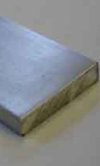High-strength aluminium
 Despite not being fettered by overbearing regulation, the use of aluminium in the production engine remains popular because the material has much merit. While there are many production applications where lower-density materials such as magnesium or non-metallics are becoming more popular, the position of aluminium in racing is assured as there are many race series that mandate its use for certain applications.
Despite not being fettered by overbearing regulation, the use of aluminium in the production engine remains popular because the material has much merit. While there are many production applications where lower-density materials such as magnesium or non-metallics are becoming more popular, the position of aluminium in racing is assured as there are many race series that mandate its use for certain applications.
While cast aluminium is likely to maintain its dominance for structural castings, there is widespread use of wrought aluminium materials for all manner of highly stressed race engine components, from the almost ubiquitous aluminium piston, to the less common aluminium con rods, through to billet cylinder heads, blocks and sumps. There are many other uses for wrought aluminium, from valvetrain components to pump housings and internals.
There are ever stronger and lighter alloys being brought to our attention in motorsport, often trickling down from the aerospace industry. These are available in a number of different strength conditions, as specified by the H or T designations. Materials that don't respond to heat treatment, such as the 5000 series alloys, are given different levels of strength by the use of deformation processes. Those that do respond to heat treatments, such as the 2000, 6000 and 7000 alloys, are classified according to both heat treatment and other deformation treatments. A cursory glance at an aluminium supplier's webpage revealed that they can supply 7075 alloy for example in 17 different grades.
Even within a given strength grade, we may not get what we expect. A supplier of complex aluminium components (specifically for motorsport), recently explained that he makes some components from blanks that he manufactures in-house from a laminated structure made from rolled plate, effectively producing a bar from a stack of round plates. These are bonded together to form bars of the correct length, which are subsequently machined.
There were a number of reasons for this, he said, but one of the most important was that the material in the centre of round-drawn bar does not undergo the same amount of deformation as the material at the outside. Consequently, the material at the centre of the bar is not at the same level of strength as that at the outside diameter of the bar. He explained that when he needs to incorporate highly loaded splines in the centre of the component, only rolled plate consistently has the required level of strength.
Fortunately for him, there is no requirement for the part to take any tensile stress in the axial direction which would load the multiple bonded interfaces. Given the complex manufacturing route, he has turned this to his advantage in other areas to produce a very successful racing product.
As with the example of the directional strength of steels given in a previous article, aluminium products also require some care in the selection of the correct material, taking into account the direction of any applied loads. Again, the processing of the material can give significant differences in strength in different directions, and the maximum loads should be, where possible, aligned with the direction of mechanical deformation.
Fig. 1 - When specifying high-strength aluminium, be sure to align the high stresses with directions having high strength
Written by Wayne Ward